Essential Images: 13 Scenes of Democracy Under Siege
From militarized raids to detention camps, these visuals expose and interrogate the country's slide into authoritarianism.
Police State
It's a stunning photo of federal agents descending on LA's MacArthur Park. It's got hints of the landing on Omaha Beach crossed with Invasion of the Body Snatchers. The performance, which included 90 armed troops and 17 military Humvees, displaced a summer day camp. Of course, the media knew to be there.
Mayor Karen Bass’s face is a study in helplessness and disgust—a direct appeal to us, the viewers, as she breaks the fourth wall. The moment's gendered theatrics are also unmistakable in the agent's obliviousness to the mayor's presence, his cowboy hat, and shouted commands.
Terror at the Court
Before Trump's shock campaign, the idea of migrants being apprehended at immigration courts was unimaginable—an abhorrent bait-and-switch as refugees appear for their hearing, trusting in the protection of due process. Today, Steffi Keith’s photograph, captured in the hallways of Federal Immigration Court in Manhattan, does more than document: it crystallizes the energy of the dragnet into a single, arresting frame. The picture is even more telltale as Democratic senators have introduced legislation to ban ICE agents from hiding their identities.
The Mass Detention Camps
It’s the darkest photo from Trump’s visit to the new migrant detention center at the Dade-Collier Training and Transition Facility in the Florida Everglades. And I refuse to call it by its promotional name.
This shot, mirroring White House photos, reveals the detention policy as agitprop. The camp, now teeming with desperate detainees, is already infamous for its squalor: reports of maggot-laced food, filthy quarters, and water shortages spill out, even as lawmakers are barred from entering.
The press (penned in too!) become unwilling extras—captive chroniclers forced to amplify the state’s narrative. The whole performance is a show of dominance, red meat for the faithful who can also collect prison-themed merch. All of it is barely protected from the oppressive Everglades, where cruelty is both the message and the medium.
A LOOK BACK: TPS and Haitians Endangered En Masse
Remember the vicious Haitian slander ("they're eating our cats") propagated by Vance and Trump during the campaign? We pictured these refugees in our post last year on the Haitians of Springfield.

What is their status now?
In late June 2025, DHS announced plans to end Temporary Protected Status for Haitians, with protections and work permits set to expire in early September. A federal judge blocked the early termination, and the government is appealing. This affects over half a million Haitians, many of whom could face deportation to their broken homeland.
SEE: Springfield's Haitian Immigrants in the Light: Amid a storm of misrepresentation, authentic portraits challenge distortions and reveal a community's true image.
Flooding Disaster: Too Little, Too Late
I’ll be posting a newsletter on the horrific flooding and tragic loss of life in Kerr, Texas. In the meantime, consider Loren Elliott’s photograph, which the Times chose to lead Trump’s visit to the region. The image, with its quietly masterful composition, stands as a counterpoint to Trump’s typical empathy-deficient, self-promotional display. It's sense of distance and near-casual detachment subtly highlights Trump’s remove and the emptiness of his gestures, especially as he’s been actively dismantling the nation’s disaster relief infrastructure.
As Trump and his team deflect and distract, the magnitude of this catastrophe—and the administration’s bungled response, with the potential to rival George Bush’s Katrina debacle—invites a torrent of metaphors. In this moment, Trump is not merely out of his depth; he’s a diminished presence at the water’s edge, eclipsed by the scale of the disaster and the peril of a climate crisis he refuses to acknowledge.
Trump's Huge, Ugly Bill
What a smart photo—the deed done in a blur. Republican members of Congress reach out to shake hands with Speaker Johnson after jamming through the whale.
Protest
Pride and Joy
Uncertainty and anxiety marked Pride Month and its many parades across the country. Out of the countless photos I saw, I’m sharing this one by Julia Nikhinson because it captures a rare moment of culture war calm.
Amid the swirl of vibrant color and movement—rainbow tutus, fishnet stockings, and the press of the crowd—there’s a quiet center. The contrast between the festive energy and the person sitting and smiling at us, arms resting on the rail, radiates stillness and resilience. It’s a reminder of the strength it takes to claim peace in turbulent times.
No Kings
There have been countless protests lately, each producing its share of striking images. Among them, Robin Fader's work stands out—her black-and-white photography for No Kings Day, captured on assignment for the BBC and Washington City Paper, reveals a sharp instinct for the political meta. With every demonstration, she manages to distill the larger narrative into a single, evocative frame.
The candor makes this pic "meme-ready."
Art, Graphics, Illustrations
The Face of Justice
Anita Kunz’s “The Face of Justice” landed quietly amid the chaos that followed the Trump assassination attempt and the opening of the Republican Convention. Still, its resonance has only sharpened as the Supreme Court’s term ends. The illustration is more than a clever visual pun—it’s an indictment and a mirror held up to the nation at a moment of profound constitutional crisis.
Rather than serving as a neutral arbiter, the Court has openly freelanced on the law, bending precedent and constitutional principle to fit the demands of a radical agenda. The image—save their hands, six clones—lays bare the reality: the judiciary, once a bulwark against executive overreach, has been captured and remade in the image of Trump and the architects of Project 2025.
Hispanic America’s 9/11
Missing posters like this one, now appearing across Los Angeles, are a haunting echo of the flyers that blanketed New York City after 9/11. Both serve as desperate calls for answers and as public memorials to those who have suddenly vanished. For many in Hispanic America, the scale of loss and fear today recalls that earlier moment of collective trauma— of safety shattered overnight.
American Spirit
Vasquez's painting is surging again on social.
Royalty
More solid graphics from New York Times Opinion. The split composition—half modern, half engraved—delivers a pointed commentary on one man rule and the cyclical nature of political hubris.
Thank you for visiting Reading the Pictures. Despite our visually saturated culture, we remain one of the few sources for analyzing news photography and media images. This post is public, so feel free to share it.
To receive new posts and support our work, consider becoming a free or paid subscriber. As a non-profit organization, your subscription is tax-deductible.




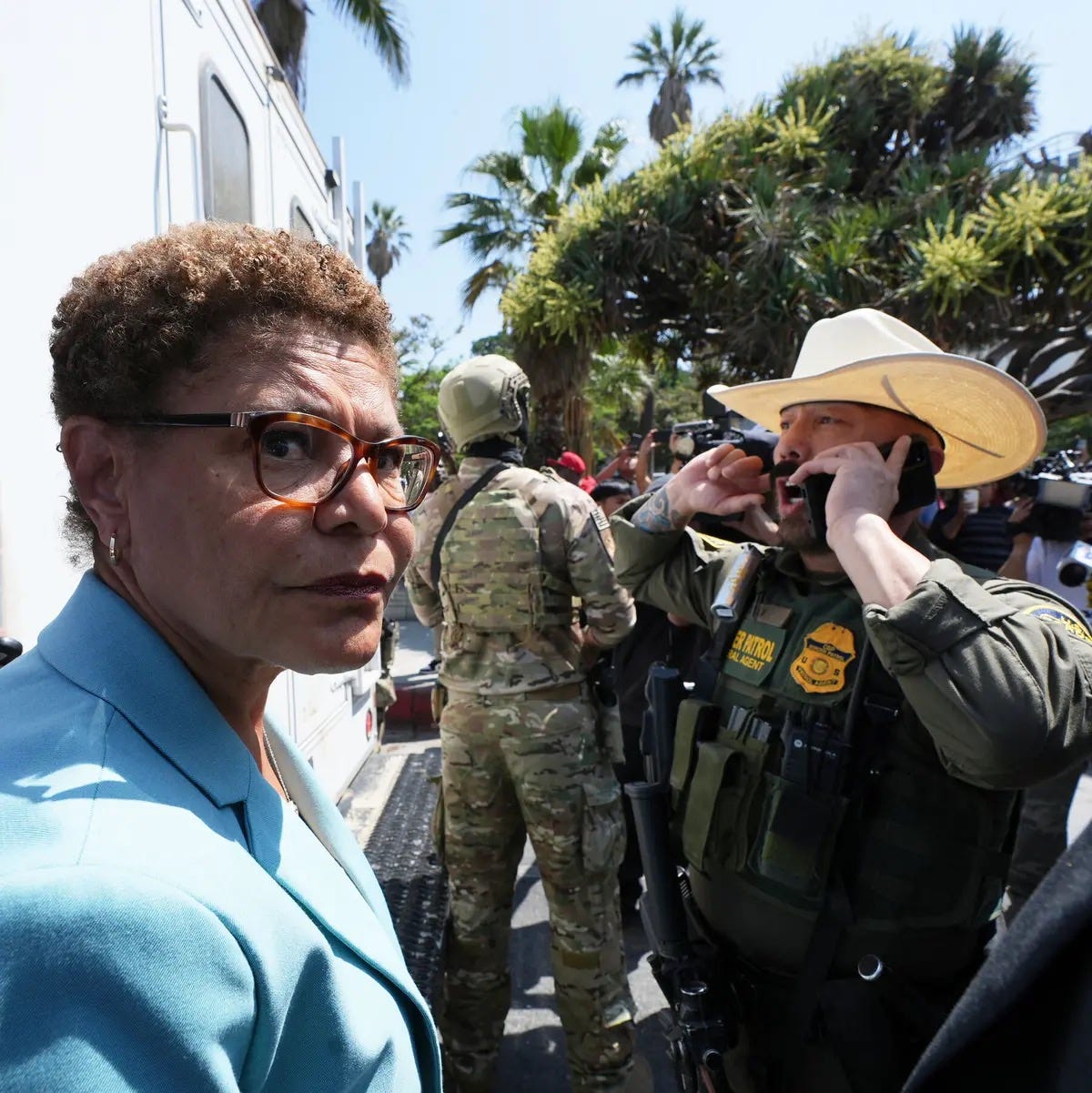
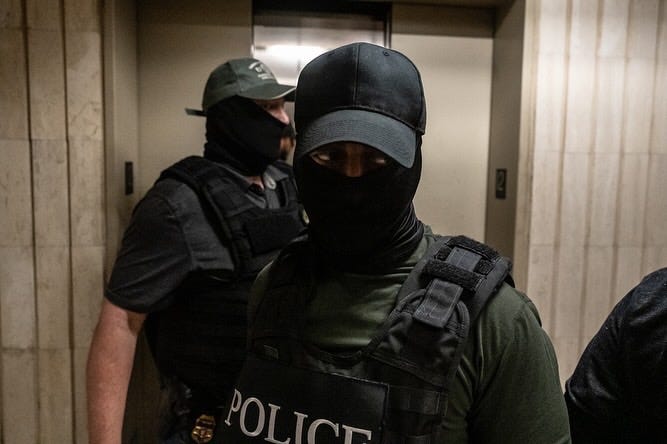
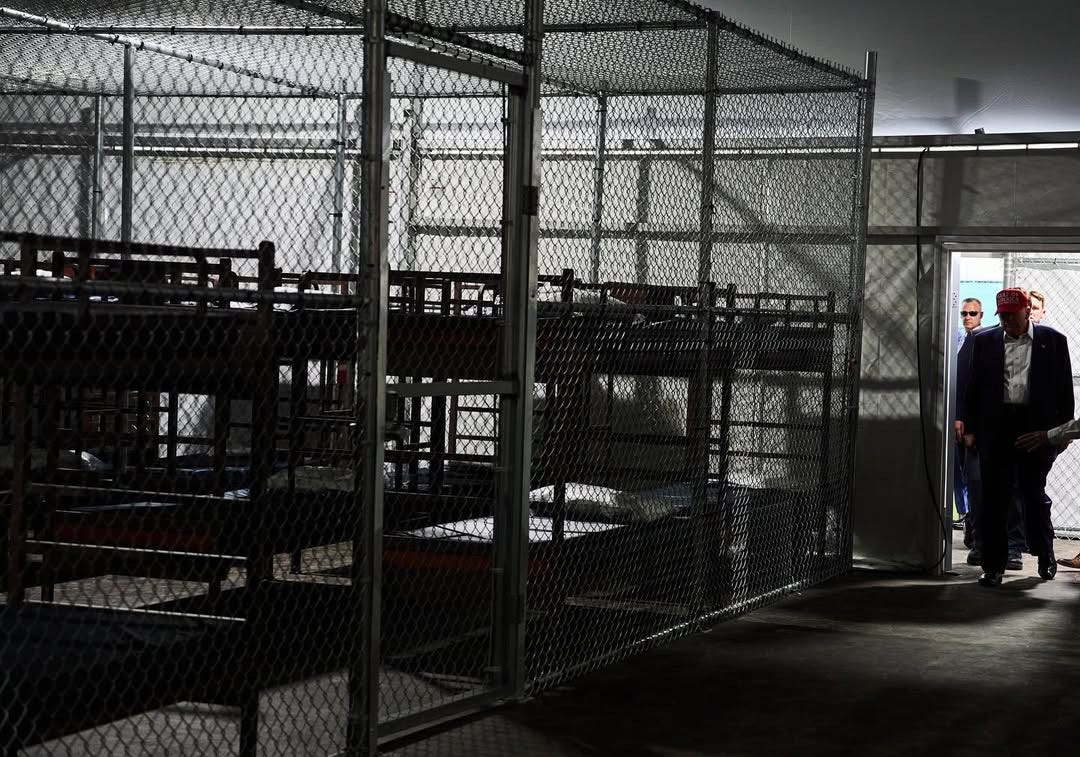





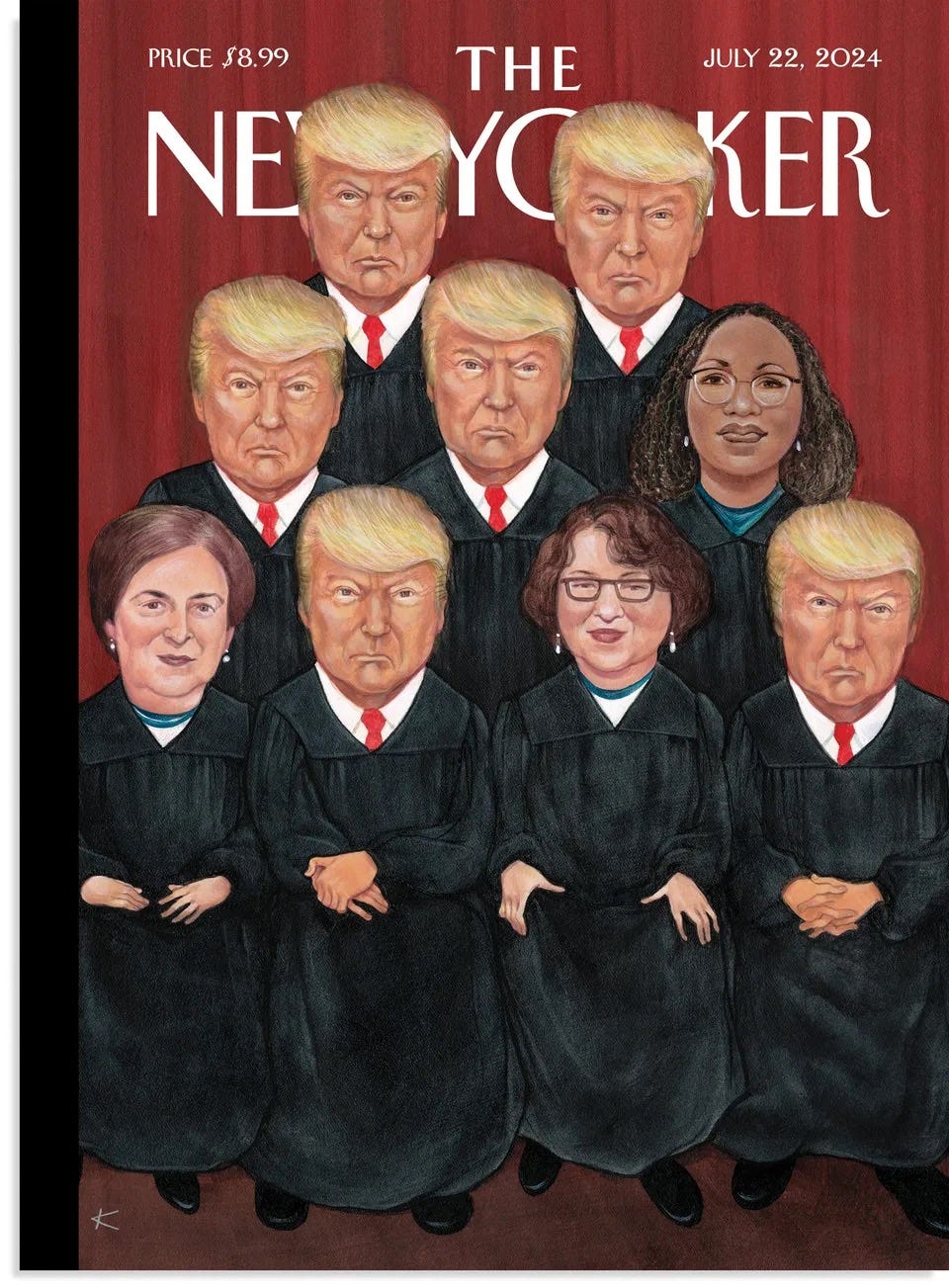


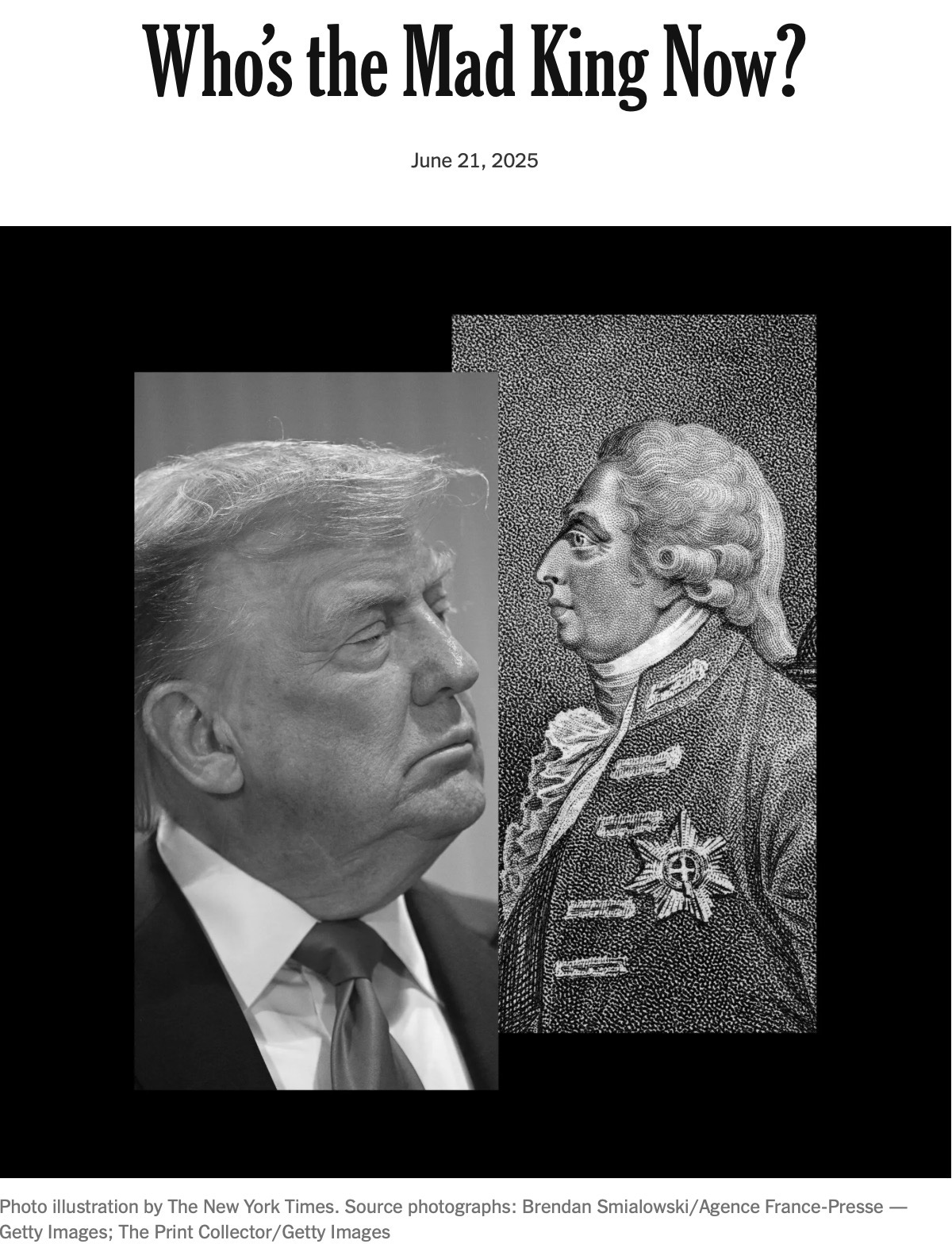
The photo from MacArthur Park looks like a scene from the French New Wave film “Last Year at Marienbad” (1961, Alain Resnais). Search Google Images and you’ll find the still photo.
I appreciate that you refuse to use the names this administration gives to its nefarious actions. When will we learn that words are everything. Words determine how we react to things. So masked, plain clothed, warrantless individuals and groups are not officials; they are assailants, kidnappers, traffickers and terrorists.
Arrest and detainment are just 2 steps in a legitimate process; folks are being abducted, kidnapped, disappeared, trafficked across state and country lines and held in concentration camps.
We have no president of government; we have a sadistic criminal enterprise run by a cruel, lawless, monster.
Thank you for the pictures. They are more than a thousand words.